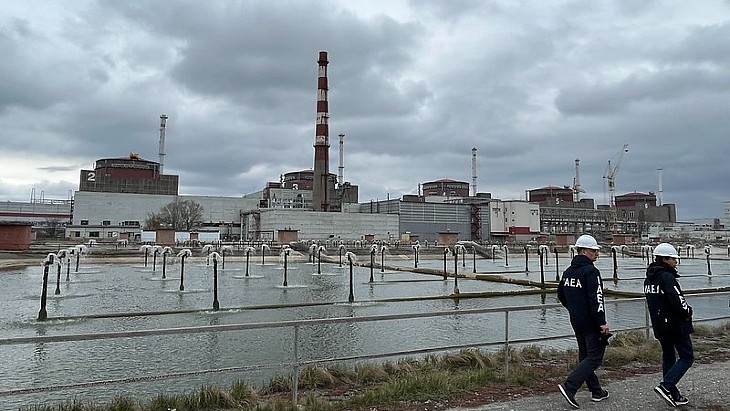Landmine explosions 'underline need for Zaporizhzhia protection agreement'
14 April 2023
 The IAEA's Grossi and IAEA experts toured the plant in March (Image: IAEA)
The IAEA's Grossi and IAEA experts toured the plant in March (Image: IAEA)The six-unit nuclear power plant, Ukraine and Europe's largest, has been under Russian military control since the start of March 2022. It is near the frontline of Russian and Ukrainian forces and has been affected by shelling on a number of occasions over the past year, as well as having had to rely on emergency diesel generators for essential safety functions in periods when it has lost all external power.
In an update on the nuclear energy safety situation in Ukraine, Grossi said it was not clear what had caused the landmine blasts outside the plant's perimeter fence on 8 April and 12 April, but added that IAEA experts at the site continued to regularly hear shelling in the area.
Grossi, who has spent months seeking to get an agreement on safety protections for the plant, said: "We are living on borrowed time when it comes to nuclear safety and security at the Zaporizhzhia nuclear power plant. Unless we take action to protect the plant, our luck will sooner or later run out, with potentially severe consequences for human health and the environment."
The IAEA director general has held talks in Ukraine and Russia, and visited Zaporizhzhia itself, in the past few weeks, to seek to strengthen nuclear safety and security at the plant - the earlier plan to create a geographical protection zone around the plant has now been modified after failing to get agreement on its details of its size and how it would work. Instead he has said the aim is to get agreement on fundamental principles.
He added: "At a time of growing speculation about military offensives and counter-offensives in the region, it is more important than ever to agree that a nuclear power plant should never be attacked, nor used to launch attacks from. I will not rest until this has been achieved."
Four of the six reactors have been in cold shutdown, with two in hot shutdown - which allows them to provide heat to the plant and the nearby town of Energodar where many of the workers live. However the IAEA said that, with the weather warming, one of the two will now be transferred to cold shutdown. Some of the nine mobile boilers used to provide extra heating have also been switched off.
The issue of external energy supply to the nuclear plant - needed for essential safety systems and for cooling - continues to be a concern, with the plant relying on a single 750kV power line for the past six weeks. A back-up 330kV power line was damaged on 1 March on the other side of the Dnipro River in territory controlled by Ukraine and the IAEA reports Ukraine as saying that "military action in the area is preventing its experts from safely accessing the location".
The nearby Zaporizhzhia Thermal Power Plant operates the 330kV open switchyard through which back-up power has been provided to the nuclear plant and also operates the pumping stations which feed cooling water from the Kakhovska reservoir to the plant - the IAEA also reports that Russia's Rosatom has said it is working to restore three 330kV lines to the grid system in Russian-controlled territory and has agreed to provide access to the IAEA team.
In other updates, Grossi reaffirmed his concern for the situation for the nuclear plant's staff and their families. The IAEA says that more than a third of the original staff have left, some have signed contracts for the new Russian operation organisation and some remain employed by Energoatom, adding: "A significant number of the latter are now on-call, with the rest - mainly key operating staff - still working at the ZNPP, under the direction of Russian appointed management. In recognition of the staff shortages, operators from Russian NPPs have been receiving simulator and on the job training at the ZNPP. Once trained, they may be asked to come to work at ZNPP in case of staff shortages."
The IAEA also reports that two additional deliveries of equipment to Ukraine had taken place, taking the total to 15 during the conflict: "With the two latest deliveries, the Ukrainian nuclear regulator SNRIU and its technical support organisation, Energoatom’s Emergency and Technical Centre, the RADON facility in Kiev and the State Enterprise VostokGOK received vehicles, personal protective equipment and IT equipment that were either donated from Israel or procured by the IAEA using extrabudgetary contributions from Australia and the United States of America."
Researched and written by World Nuclear News
No comments:
Post a Comment